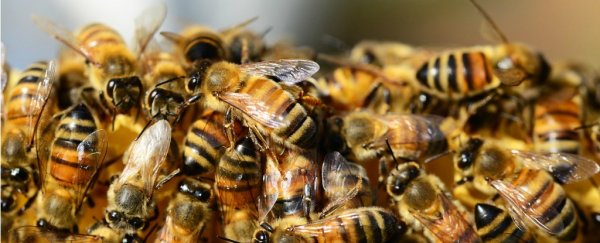For years, there's been suspicion that a class of pesticides known as neonicotinoids are bad for bees. The chemicals, which farmers apply to their crops to keep away insects that munch through their harvests, are among the most used bug-killers out there.
But ecologists have worried the chemicals also affect the insects that help support harvests.
Bees have been mysteriously disappearing in what's called colony collapse disorder, which some scientists believe neonicotinoids are contributing to.
That's a problem because the pollination work bees do is hugely valuable. Commercially managed honeybees produce about $US15 billion in value for the US alone and wild American bees another $US9 billion.
There's finally a study that tries to actually parse out the effects neonicotinoids have on bees in the wild. It looks at 62 different wild bee species in the UK.
That's important because while only three species of bees and bumblebees are kept by beekeepers and used commercially, experts believe there are closer to 250 wild species in the UK and 4,000 in the US. And while we don't manage them, we do benefit from their pollination.
The new study, which was published August 16 in the journal Nature Communications, also looks at an 18-year timespan that begins before neonicotinoids were introduced in 2002. That means the researchers could actually establish a baseline for how bees were doing before farmers began widely using the chemicals.
Neonicotinoids are used particularly on rapeseed, one variety of which is turned into canola oil. During the month or two they bloom, the flowers turn swaths of the British countryside a shocking yellow.
Some bees like the flowers; some don't. So the scientists were able to divvy bees up by their taste for rapeseed, then look at how their populations changed over almost two decades of surveys.
For a few bees, the scientists estimate about a fifth of their population declines was due to neonicotinoids.
That's not enough to kill off bees taken by itself. But pesticides aren't the only challenge bees are facing. Climate change, differences in how we use the land and what plants they can feed on, and parasites and diseases that infect bees are also putting a dent in populations.
And it doesn't necessarily mean we should stop using neonicotinoids cold turkey. "It needs to be taken in a very holistic perspective, you can't just say as long as we can save the bees everything else can go to hell, that's not where you want to be at," lead scientist Ben Woodcock told the BBC.
Both the Environmental Protection Agency, which regulates pesticides in the US, and the European equivalent are already in the process of re-evaluating their rules for neonicotinoids.
The study isn't quite the gold standard of science, since the researchers were just watching what happened from changes already in place rather than carefully controlling circumstances so that pesticide exposure was the only difference between groups.
But that kind of study is really hard to do in ecology - and getting a long-term, large-scale look at a range of species is better information than we've had before.
This article was originally published by Business Insider.
More from Business Insider:
